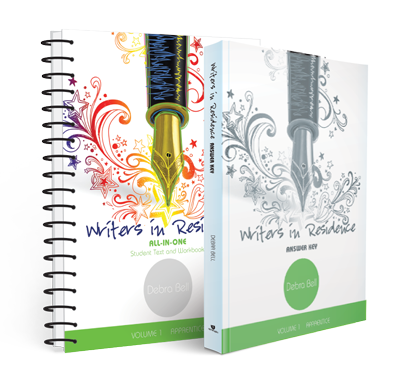
The Writers in Residence student book is an all-in-one volume that contains both textbook and workbook activities. An accompanying Answer Key for the parent/teacher contains both defined answers (ie, for grammar/editing questions) and suggested answers (for writing exercises), but no teaching guides/materials. We received the full curriculum bundle that contained both books, but each is also available for individual purchase.
Traditional writing programs generally divide instruction units by style (expository, persuasive, personal, etc.) and teach writing from that genre's singular viewpoint. However, most writing that adults do doesn't cleave along these tidy lines. For example, this review spans multiple genres and is both expository and narrative in its presentation; a good editorial will be both expository and persuasive. Writers in Residence prepares writers for this "real world" style of writing by presenting writing in topical contexts instead of stylistic. It allows young writers to find a single, encompassing writing voice that will shine through all of their pieces, rather than having many individual style-driven personalities.
The spiral bound student book is fully consumable. I appreciated that this was a single integrated book, but the combination of text and writing makes this book approach 600 pages!
The thickness also often made it difficult to write in; either it was too thick under Matthew's hand or the huge spiral was in the way. Matthew liked the idea of a mixed text and workbook but thought it might be better if it was split into two "semester-long" books. However, I was frustrated at not having a separate text to refer to. If he had a question, either he had to come to me with the book, or I would have to stop what I was doing to come read the instructional texts over his shoulder. It just felt awkward to use simultaneously as both instructional and practice.
Included towards the beginning of the student book is a suggested daily schedule, and the entire program is intended to take 32 weeks (a full school year).
Matthew and I liked the schedule inclusion, even if we disagreed on how to implement it. Generally, assignments were kept to one or two activities per day, while four-day weeks allowed flexibility for scheduling. For the purposes of this review, Matthew followed the suggested schedule for his first essay. However, none of the individual lessons was particularly long; some were under five minutes for him! For a fourth grade student, the suggested schedule is steady yet not overwhelming, but an older student could easily complete two or three lessons each day.
Each module includes a clear, points-based grading system for activities, along with a reasonably objective scale.
While whether an activity merits "exemplary" vs. "acceptable" scores is subjective on my part, it did show Matthew a clear line for creating an essay. Because it showed each task, I could where in the process he lost his way before the essay was irretrievable. Here had only six sentences instead of the required ten. Neither did he follow the activity's direction to write individual sentences; instead he wrote a short draft paragraph.
Using this step-by-step checklist, we were able to back up immediately so that he only had one "needs improvement" instead of amassing six. Units also include a clear rubric to guide both writing and grading the completed essay.
We completed the first module completely. I was underwhelmed by his progress. I understand the program's initial directions to simply write sentences as they come to you, and then physically move them around into the final order. I think that makes a lot of sense for a kinesthetic learner. I remember writing a term paper in college where I had post-its lined up above my dorm bed and physically rearranged them to organize my thoughts. However, rather than writing a paragraph with a defined topic and supporting sentences, it seemed like Matthew simply wrote a bunch of topical sentences and arranged them in paragraph form. Given that this curriculum is for middle elementary students, I can't be shocked that what he wrote WAS a fourth-grade paragraph. However, that's not acceptable when your academic grade level is much higher.
One assignment was to write a paragraph that focused on using strong verbs. While still not the best of paragraphs, focusing on it as a single paragraph and not a conglomerate of sentences led to a higher scoring level.
Thinking the concept and content of the program is better for younger students, I considered getting the program for Jude (3rd grade) but ultimately have decided not to. Practically speaking, the thickness of the book is difficult for him to write. I considered breaking the book down and having it rebound, but the program book already is $80, and rebinding would push the cost further up. The student book also does not grant any reproduction rights (even within the same household), so the program can't be used with multiple students in a family to amortize the costs. I would rather see program materials modeled after Apologia's science reusable text plus consumable workbook programs. I had hoped that this would help Matthew become a better writer. It has shown me some specific areas of weakness that he needs more assistance with, but, unfortunately, the program itself it didn't work out to be right for him.
To learn more about Apologia's programs or to read other reviews of Writers In Residence, follow Apologia on social media or clck the banner below.
Facebook: http://www.facebook.com/apologiaworld
Twitter: http://www.twitter.com/apologiaworld
Pinterest: https://www.pinterest.com/apologia/
Instagram: http://www.instagram.com/apologia

©2012- 2016 Adventures with Jude. All rights reserved. All text, photographs, artwork, and other content may not be reproduced or transmitted in any form without the written consent of the author. http://adventureswithjude.com









No comments:
Post a Comment